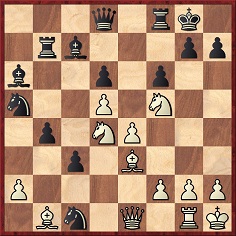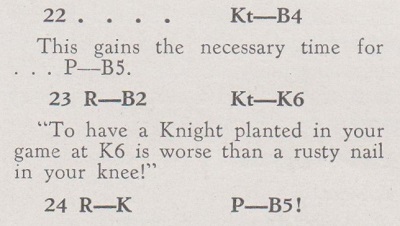
Edward Winter
No reliable anthology of chess quotations exists in any language; to date there has been just the occasional brief throw-together of alleged bons mots, all of them sourceless. Nothing stamps a writer as untrustworthy more swiftly than an expectation that what he writes should be taken on trust.
There is something carefree and almost random about how the chess world attributes many writings and sayings to persons (Tartakower is a safe bet) and nations (‘Old Russian proverb’), and this often makes it impossible for the reader to determine what is genuine, erroneous or bogus. Our recommendation is to dispense with any publication or website which offers ‘chess quotes’ without indicating where and when the statements in question were purportedly made.
On page 279 of The Chess Companion (New York, 1968 and London, 1970) I. Chernev attributed the following to Tartakower:
‘The great master places a knight at K5; checkmate follows by itself.’
As was pointed out in C.N. 2194 (see pages 338-339 of A Chess Omnibus), Tartakower merely quoted an onlooker at a game won by O. Bernstein in Paris in 1933. On page 426 of L’Echiquier, 17 February 1934 Tartakower wrote:
‘“Ces grands-maîtres placent leur[s] Cavaliers à é5 et après les mats découlent d’eux-mêmes!” dit en voyant cette catastrophe un spectateur grincheux.’
A similar remark appeared on page 111 of Chernev’s The Bright Side of Chess (various editions, except the New York, 1961 version, which mysteriously omitted the Epigrams chapter):
‘Once get a knight firmly posted at king 6 and you may go to sleep. Your game will then play itself.’
This is attributed to Anderssen, whereas on page 174 of CHESS, 8 January 1955 Steinitz was said to have declared:
‘Let me establish an unassailable knight on K6 and I can go to sleep for the rest of the game.’
Can a reader provide a respectable nineteenth-century source relating to Anderssen, Steinitz or anybody else?
(3514)
C.N. 1485 quoted the following from page 61 of Volume II of Tartakower’s Best Games:
‘The art of chess is simple: you play Kt-B3-K5 and then, sooner or later, KtxKBP is decisive.’
An additional claim was on page 59 of Modern Master-Play by F.D. Yates and W. Winter (London, 1929):
‘Marshall is very partial to posting a knight on Q4, and certainly the piece is very effective there, as he is within range of a number of vital squares, notably KB5 and K6. Of the latter Anderson [sic] said: “If a player can firmly plant a knight on K6 he can go to sleep for the rest of the game”.’
(9375)
An observation by Zukertort after 26 Ne6 in the simultaneous game Steinitz v Maas, London, 5 November 1873:
‘The appearance of the knight at K6 is generally, for the opponent, the proper signal to strike his colours.’

26 Ne6 Qe8 27 Bxc1 Rf7 28 g4 Qa4 29 g5 c2 30 gxf6 cxb1(Q) 31 Nh6+ Kh8 32 Nxf7+ ‘and mates next move’.
Source: City of London Chess Magazine, May 1874, pages 97-98.
When the game Steinitz v von Bardeleben, Hastings, 1895 was shown in a ‘Chess Movies’ article on page 336 of the November 1949 Chess Review, the following comment referred to 19 Ne6:
‘A knight at K6 is like a bone in the throat, says Steinitz.’
For the same attribution, see I.A. Horowitz’s books How to Win in the Chess Openings (New York, 1951), page 44, and How to Win at Chess (New York, 1968), page 50, but where did Steinitz make the comment?
From page 212 of the first volume of Kasparov’s Predecessors series, before 16 Ne6 in Lasker v Capablanca, St Petersburg, 1914:
‘... the knight at e6 will be like a bone in his throat!’
Exclamation marks do not enliven clichés.
(9865)
From Elements of Positional Evaluation by Dan Heisman (Coraopolis, 1990), pages 21-22:
‘There are many famous quotes on these subjects, like Adolph [sic] Anderssen’s “Once get a knight firmly posted on King 6 and you may go to sleep. Your game will then play itself.”’
From Elements of Positional Evaluation by Dan Heisman (Milford, 2010), page 28:
‘There are many famous quotes on these issues, an example being Steinitz’s “Let me establish an unassailable knight on K6 [e3/e6] and I can go to sleep for the rest of the game.”’
In each case Heisman provided a sort of source: respectively, ‘Chernev, The Bright Side of Chess, p. 111’ and ‘Chess, Jan. 8, 1955, p. 17’. Both those references were mentioned in C.N. 3514, but they lead nowhere. The latter was merely a sourceless answer to a Christmas quiz.
An addition from page 27 of How Not to Play Chess by E. Znosko-Borovsky (London, 1931):
‘The great Steinitz used to say that if he could establish a Kt at his K6 or Q6, he could then safely go to sleep, for the game would win itself.’
(9874)
A question asked by Jerry Hanken on page 15 of Chess Life, September 2005:
‘Was it Tarrasch who said a knight on d6 is like a rusty nail in the knee?’
A number of bottom-of-the-range Internet pages sourcelessly ascribe such a remark to Bogoljubow, the square occupied being given as e6/e3.
On page 58 of Chess Strategy and Tactics by Fred Reinfeld and Irving Chernev (New York, 1933) the observation appeared in quotation marks, but unattributed, in the game Bogoljubow v Réti, Mährisch-Ostrau, 1923:

Elsewhere, Anderssen and Steinitz have been named. Below, for example, is a footnote on page 112 of Chess Traps, Pitfalls, and Swindles by I.A. Horowitz and Fred Reinfeld (New York, 1954), concerning White’s move Nd6:
‘Of such powerfully posted knights the immortal Anderssen remarked, “They are like a rusty nail in your knee!”’
From page 93 of Bishop versus Knight: The Verdict by Steve Mayer (Seattle, 1997):
‘There’s an old line, generally attributed to Steinitz, that a knight at e6 is like a rusty nail in the knee.’
Another variant comes from page 87 of Reinfeld’s Great Short Games of the Chess Masters (New York, 1961), after 10 Nc6:
‘Of such knights, posted deep in the enemy’s territory, it has been truly said that they are “like a rusty nail in your knee”.’
Who can say whether Anderssen, Steinitz, Tarrasch, Bogoljubow or somebody else made such a remark about a knight on Q6, K6, QB6 or KB6 – or, indeed, whether the nail-like occupant was necessarily a knight? The annotation below is by Jack W. Collins on page 19 of the November 1947 Chess Review:
‘He has two bishops, a passed pawn at K6 (a rusty nail in the knee, according to Steinitz), and aggressively placed rooks.’
(10635)
From Christian Sánchez (Rosario, Argentina):
‘Your feature article gives the earliest date for the Anderssen quote as 1929. In the notes to the move 15...QR-Q1 in the Lasker-Capablanca game (St Petersburg, 1914, round 18), page 66 of The Grand International Masters’ Chess Tournament at St Petersburg, 1914 (Philadelphia, [1914]), quotes Louis van Vliet in the Sunday Times:
“Why allow Kt-K6, while it could be prevented by B-B1? The great Anderssen used to say: ‘Once get a Kt firmly posted at K6 and you may go to sleep. Your game will then play itself!’ (V.)”.’
See note (e) below in the full column published on page 17 of the 31 May 1914 edition of the Sunday Times:

To the Chess Notes main page.
To the Archives for other feature articles.
Copyright: Edward Winter. All rights reserved.